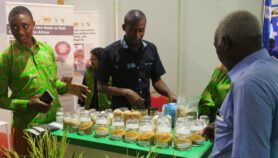By: Sonia el-Ali
Send to a friend
The details you provide on this page will not be used to send unsolicited email, and will not be sold to a 3rd party. See privacy policy.
(IDLIB) Amid a shortage of humanitarian aid and increased fuel prices, Syrians have discovered a cheap way to get warm in the harsh winter — by recycling missiles.
Humanitarian aid covers only 45 per cent of the population’s needs and poverty rates have reached an unprecedented 90 per cent in northwest Syria, according to the Syrian Response Coordination Group, leaving many people to resort to makeshift heaters, run on toxic fuels.
As’ad al-Obaid, sitting around one of the repurposed weapons with his children in their home city of Jisr al-Shughur, in Idlib province, tells SciDev.Net: “I couldn’t afford a heater, so got a missile I found nearby, gave it to the blacksmith and got this heater”.
During the country’s decade-long conflict, getting warm has become a luxury that al-Obaid’s family and others like them in the northwest Syrian city cannot afford. The alternative here is to rely on whatever is available, including cheap fuel — regardless of the health risks.
This fledgling recycling industry sees blacksmiths hurry out to gather missiles with a radius of between 28 and 32 cm, and take them to their workshops. Or sometimes they even buy the missiles at a low price.
Ahmed Hussein al-Othman is a blacksmith in Idlib who has ventured into this line of business. He says: “The big increase in iron prices made it difficult for many residents to purchase expensive heaters, so people turned to this new option.”
Describing the manufacturing process, he says: “The first stage is using the fragments of missiles found, or taking the unexploded ones and breaking them down into pieces. [You need to] get experts to take out [any remaining] explosives and eventually sell these to quarries to be used in blowing out rocks.”
Then, the missile is carried to the workshop where the upper part is removed and a side crack is made to release fumes, al-Othman explains.
He says that the strong metal used in manufacturing the missiles makes them more resilient to sustained high temperatures. They are also cost-effective, he says, at only $US15, compared to around $US100 for a new heater.
The missile-turned-heater can work with coal, wood, pyrene or nylon, al-Othman adds.
Al-Obaid obtains pyrene from olive oil press machines in northern Syria, as a by-product that is then compressed, dried and sold in the form of cylinders.
He believes that, despite its bad smell and health risks, pyrene is still a good option as it includes oils that make it combust more easily than wood. Being cheap, coal is also seen as a perfect fit.
Jalal al-Shardoub, a resident of Kelli refugee camp, north of Idlib and a father-of-five, says he uses coal to fuel his heater, despite its bad smell and negative effect on his children. The coal used is a by-product of primitive oil refining procedures, with 1kg of coal costing about $US1.5.
Other residents cannot even afford these rudimentary and dangerous heat sources. Instead, they head to landfill sites to sift through piles of waste until they find something to burn to generate heat.
Fatima Al-Terzi lives with her six children in an unfinished house with no doors or windows on the outskirts of Idlib, after losing her husband in a shelling by forces loyal to President Bashar al-Assad. She tells SciDev.Net, about her daily ritual of going with her children to landfill sites and collecting plastic bags and cardboard to burn. Despite their bad smell, she says this is her only choice.
Abdelkhaliq al-Sheikh, a petrochemical engineer and director of water quality and standards for Idlib, explains the damage caused by these alternative heat sources: “When using diesel oil or domestic gas to generate heat, combustion is complete and carbon dioxide is generated, which is less damaging due to the release of water vapour.”
However, if combustion is incomplete — as with burning wood, coal and pyrene — a mixture of gases are emitted, he says. The main one of these is carbon monoxide, which is highly toxic, causes respiratory diseases, and can even lead to asphyxia.
If nylon is burned, sulphur dioxide or hydrogen sulphide is released, says Al-Sheikh, which are both highly toxic gases that can get into the lungs and absorb water from them.
Mohammed al-Khaled, director of primary health care in the town of Selqin, in northern Idlib, says: “Garbage and shabby clothes and shoes became a normal way of generating warmth for many residents and displaced people in Idlib, as they are handy and low-cost when compared to traditional ones like wood or fuel.”
He stresses that these methods are very dangerous and might even lead to death when used in enclosed spaces.
Al-Khaled tells SciDev.Net that 50 per cent of the children who visit his health care centre have respiratory diseases, due to these unhealthy ways of generating heat. Diseases such as bronchial asthma, chronic bronchitis, respiratory failure and hypoxia, which affect children’s growth and development, could accompany them for the rest of their lives.
This piece was produced by SciDev.Net’s Middle East and North Africa desk.















